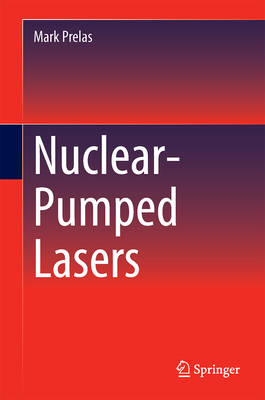
- Afhalen na 1 uur in een winkel met voorraad
- Gratis thuislevering in België vanaf € 30
- Ruim aanbod met 7 miljoen producten
- Afhalen na 1 uur in een winkel met voorraad
- Gratis thuislevering in België vanaf € 30
- Ruim aanbod met 7 miljoen producten
Zoeken
Omschrijving
This book focuses on Nuclear-Pumped Laser (NPL) technology and provides the reader with a fundamental understanding of NPLs, a review of research in the field and exploration of large scale NPL system design and applications.
Early chapters look at the fundamental properties of lasers, nuclear-pumping and nuclear reactions that may be used as drivers for nuclear-pumped lasers. The book goes on to explore the efficient transport of energy from the ionizing radiation to the laser medium and then the operational characteristics of existing nuclear-pumped lasers. Models based on Mathematica, explanations and a tutorial all assist the reader's understanding of this technology.
Later chapters consider the integration of the various systems involved in NPLs and the ways in which they can be used, including beyond the military agenda. As readers will discover, there are significant humanitarian applications for high energy/power lasers, such as deflecting asteroids, space propulsion, power transmission and mining.
This book will appeal to graduate students and scholars across diverse disciplines, including nuclear engineering, laser physics, quantum electronics, gaseous electronics, optics, photonics, space systems engineering, materials, thermodynamics, chemistry and physics.
Early chapters look at the fundamental properties of lasers, nuclear-pumping and nuclear reactions that may be used as drivers for nuclear-pumped lasers. The book goes on to explore the efficient transport of energy from the ionizing radiation to the laser medium and then the operational characteristics of existing nuclear-pumped lasers. Models based on Mathematica, explanations and a tutorial all assist the reader's understanding of this technology.
Later chapters consider the integration of the various systems involved in NPLs and the ways in which they can be used, including beyond the military agenda. As readers will discover, there are significant humanitarian applications for high energy/power lasers, such as deflecting asteroids, space propulsion, power transmission and mining.
This book will appeal to graduate students and scholars across diverse disciplines, including nuclear engineering, laser physics, quantum electronics, gaseous electronics, optics, photonics, space systems engineering, materials, thermodynamics, chemistry and physics.
Specificaties
Betrokkenen
- Auteur(s):
- Uitgeverij:
Inhoud
- Aantal bladzijden:
- 417
- Taal:
- Engels
Eigenschappen
- Productcode (EAN):
- 9783319198446
- Verschijningsdatum:
- 22/11/2015
- Uitvoering:
- Hardcover
- Afmetingen:
- 161 mm x 20 mm
- Gewicht:
- 832 g

Alleen bij Standaard Boekhandel
+ 377 punten op je klantenkaart van Standaard Boekhandel
Beoordelingen
We publiceren alleen reviews die voldoen aan de voorwaarden voor reviews. Bekijk onze voorwaarden voor reviews.








